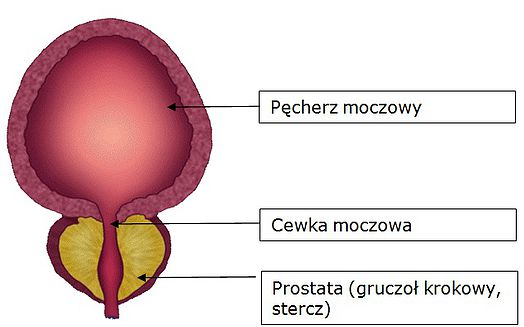Menu
Information for the patientBenign prostatic hyperplasia
What is prostate?
The prostate or the prostatic gland (Latin: prostata) is an azygous musculo-glandular organ, constituting a part of the male genital system. It is located below the bladder in the small pelvis, and the prostatic part of the urethra runs through its parenchyma. The prostate is shaped like a chestnut (a flattened cone). On the outside, it is surrounded by a strong capsule of smooth muscles, which contract during ejaculation.
The function of the prostatic gland is production of secretion, which fluidizes semen and makes it resistant to the acidic environment of the vagina.

What is Benign Prostatic Hyperplasia – BPH?
Benign prostatic hyperplasia (BPH) is one of the most frequent urological diseases in men, associated with age. In almost one half of all men after 60, clinical symptoms of BPH can be observed, resulting in significant deterioration of life quality, while complications, such as recurring infections of the urinary tract, cystolithiasis or kidney infections are a cause of health deterioration. The main and most frequently occurring symptom, indicating BPH, is hindered outflow of urine from the bladder.
According to epidemiological data, the percentage of men displaying the symptoms in the prostate, increases to about 10% after reaching 45 years of age to as many as 90% in the 80th year of age. Estimates for the population of Poland provide for the number of more than 2.5 million patients, suffering from ailments associated with BPH.
The primary cause of the illness is narrowing of the urethra at the level of the prostatic gland, resulting in hindered urine flow. This is due to two mechanisms. Direct pressure from the outside of the enlarged prostatic gland on the urethra (the mechanical component) and contraction of smooth muscles in the area, also exerting pressure on the urethra (the dynamic component). These two components determine the clinical image of BPH, where intensification of symptoms is not dependent directly on the size of the prostatic gland. Existence of the so-called bladder outlet obstruction results in the so-called lower urinary tract symptoms (LUTS), which include irritation (urgent tenesmus, pollakiuria, urinary incontinence) and obstruction-related symptoms (difficulties in starting miction, weak urine stream, prolongated miction, urine drops after urination, sensation of incomplete emptying of the bladder). Ignored and untreated symptoms may lead to damaging of the bladder, and in extreme cases – the kidneys. These may result in cystolithiasis, retention of urine requiring a catheter, and even serious dysfunction of the kidneys.
Diagnosis and treatment
BPH is diagnosed by a doctor on the basis of a detailed medical history, quantitative assessment of the ailments, physical per rectum examination, urinalysis, PSA concentration in blood serum (prostate-specific antigen) and other tests, depending on the situation and condition of the patient. The scope of therapeutic treatment of patients with BPH is very broad and includes the so-called cautious anticipation, when the patient is subject only to observation, pharmacological therapy and surgical methods. The main objectives of pharmacological treatment is quick, effective and long-term reduction of symptoms of LUTS, counteracting bladder outlet obstruction, prevention of acute retention of urine and reduction of the risk of need for surgical treatment. The necessity of surgical intervention arises in those patients, who do not respond to pharmacological treatment aimed at elimination of the symptoms of the disease.
Prepared on the basis of:
Rola farmakoterapii skojarzonej w leczeniu BPH i męskich LUTS. A. Borkowski,
M. Sosnowski, Z. Wolski, R. Zdrojowy, M. Słojewski, P. Radziszewski, P. Chłosta, T. Drewa, T. Borkowski. Opinia ekspertów. Przegląd Urologiczny 2011/3,5 (67, 69).
Łagodny rozrost stercza – zagadnienia wybrane, część I i II. Podstawy leczenia farmakologicznego. I. Ostrowski. Przegląd Urologiczny 2006/5,6 (39,40).